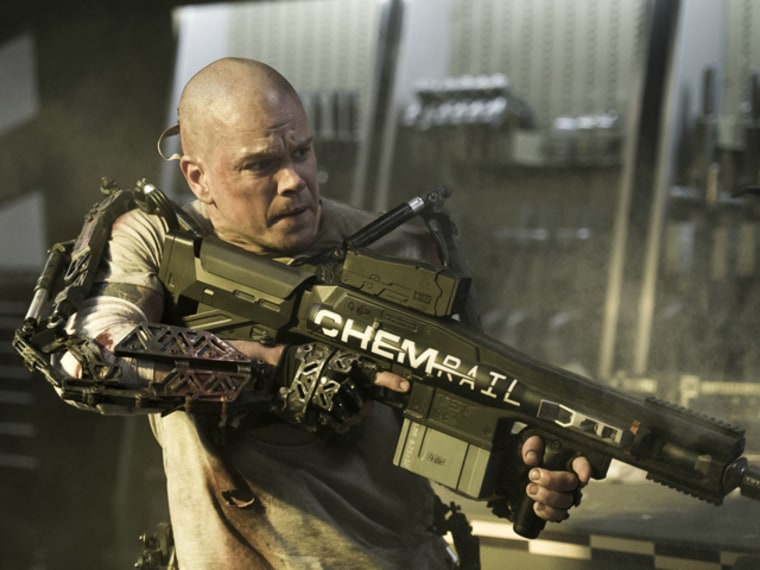Hollywood’s summer of the super soldier — featuring tech-bedecked troops like Matt Damon in the No. 1 movie “Elysium” — offers a flicker of futuristic battle gear as the real U.S. military explores innovations from exoskeletons to advanced armor to outfit the next-gen combat fighter.
At the laboratories of Special Operations Command (SOCOM) in Tampa, Fla., one project is dubbed TALOS — tactical assault light operator suit — and the blueprint involves blending an array of emerging technologies into a single, gizmo-rich, body-shielding uniform.
“How do we take the best of what’s out there — being academia, large industry, small industry or just three guys with a bright idea — and focus that energy toward the (special) operator to give him better protection and better capability?” said Jim Geurts, who oversees science and tech development, procurement and production for Special Operations. The command includes elite forces like Army Rangers and Navy SEALS.
“Certainly that involves body armor. But it also involves: How do I get them better situational awareness? How do I get them better communication? How do I allow them to move better without getting hurt?” Geurts said. “How do we continue to focus technology innovation and the good-old-American-monster-garage kinds of things to continue to help the operator?”
In July, SOCOM held a unique trade show in Tampa that mixed private scientists who are ramping up designs on exoskeletons (high-powered, wearable machines) or who are bolstering display technologies or creating tomorrow’s armor. The goal was to assemble the masterminds in the same room, Geurts said.

“There’s not a place right now where all of them get together with a (special) operator and say, ‘OK, can I put this radio on your exoskeleton, and how much power does it need?’” Geurts said. “Everybody brought their LEGO building blocks and we could see all the types of LEGO building blocks, and we could start to think about how we put those blocks together to build something to give the operators capability that they don’t have now."
The public can glimpse the creative thinking behind such revolutionary gadgetry in pop films like “Elysium,” in which Matt Damon’s character sports a black-metal exoskeleton plugged into his mind and spine, boosting his strength allowing him to download others’ thoughts. In another summer movie, “Pacific Rim,” pairs of soldiers mutually operate giant exoskeletons to combat sea monsters.
Do these sci-fi films marry today’s silver-screen fantasy with any tiny germ of tomorrow’s battlefield reality?
“Maybe conceptually,” Geurts said. “Certainly, the idea of having mobility with protection with the ability to understand the environment around you and communicate to others around you — those facets are all important.”
Similar techno advances are in play across other branches as military commanders collaborate with top science minds to push the bounds of soldier suits.
Norman Wagner, a professor of chemical and biomolecular engineering at the University of Delaware, has worked with the U.S. Army Research Laboratory in Maryland to co-invent a liquid armor called Shear Thickening Fluid. His material could coat Kevlar vests and Kevlar helmets, transforming them into something better: When a bullet or bomb fragment strikes the service member, miniscule particles in the liquid ceramic instantly reorganize themselves and harden to block the projectile.
“The idea is, you want a body armor that’s flexible so you can wear it,” Wagner said. “But at the point of impact, the fluid acts more like a solid in protecting the person behind it.”
Wagner has another project in the works that similarly seems tailor-made for military use: He, a University of Delaware colleague and a student are investigating a chemical-polymer technology that allows material to self mend.
"If you get a cut or a puncture, the material would heal itself the same way that biological systems respond to skin wounds,” Wagner said.
While Wagner said the price for his Shear Thickening Fluid is relatively low and on par with “commercial costs,” this is the age of federal sequestration. At Special Operations Command, the innovators are taking lean times to heart.
“The challenge is two-fold: one, the collection of items called TALOS and, two, reinventing the next-generation business-acquisition model that let’s us quickly and cheaply attract those technologies to help the guys,” Geurts said.
Special Ops wants to tap the best ideas and the newest technologies — where ever they may be — allowing the command to collaborate with “non-traditional suppliers.” That is far different from picking a large contractor and paying big bucks to complete a project.
Military leaders acknowledge they have learned hard lessons in bolstering body protection and other battlefield gear for troops during 12 years of war, leading to better equipment already in place. But as the next phase of upgrades rolls from concept to the laboratory to the production line, they will be quickly installed in the field. The re-outfitting of troops in soldier suits 2.0 is not a distant theory, Geurts said.
"We're creating the environment where we can continue to improve and improve and improve," he said. "And if I can do something in two weeks that helps the guys, then that’s two weeks better than what I can give them today."
